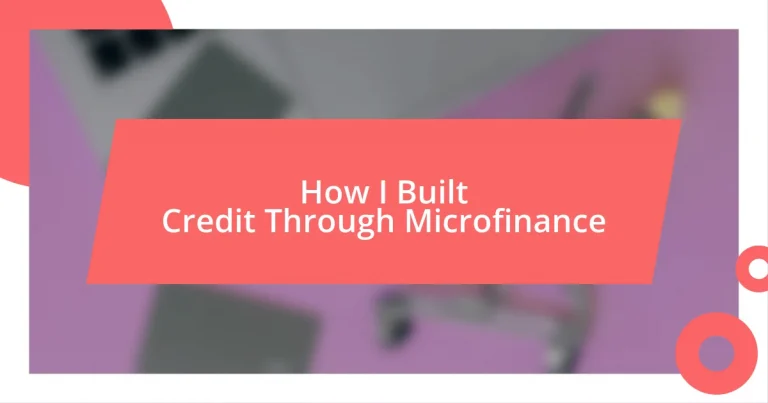Key takeaways:
- Microfinance provides essential financial services to those without access to traditional banking, enabling credit building and fostering community resilience.
- Building credit is crucial for financial independence, impacting access to better interest rates, increased borrowing power, and improved job prospects.
- Choosing the right microfinance institution and actively managing loans—through budgeting and communication—are key strategies for successful credit development and future growth.
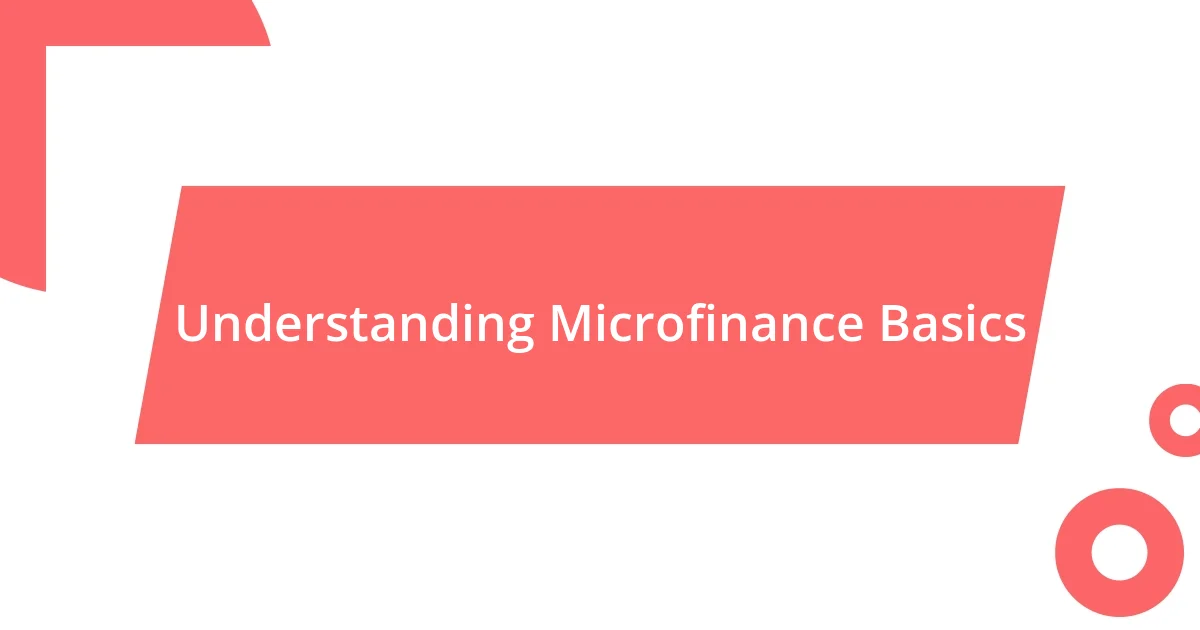
Understanding Microfinance Basics
Microfinance is essentially financial services tailored for individuals or small businesses who lack access to traditional banking. When I first discovered microfinance, I was struck by the idea that just a small loan could ignite someone’s entrepreneurial dream. How incredible is it that, for many, these tiny financial boosts can transform lives?
This model champions the idea of inclusivity, enabling people to build credit, improve their livelihoods, and contribute to their communities. I vividly remember chatting with a local shopkeeper who had expanded her business through a microloan; her pride was palpable. It made me realize how even the smallest investment could plant the seeds for significant change and community resilience.
At its core, microfinance isn’t just about lending money—it’s about nurturing hope and opportunity. Have you ever thought about how a little support can empower someone to change their circumstances? Witnessing firsthand the impact of these services has deepened my appreciation for their role in fostering growth and self-sufficiency.
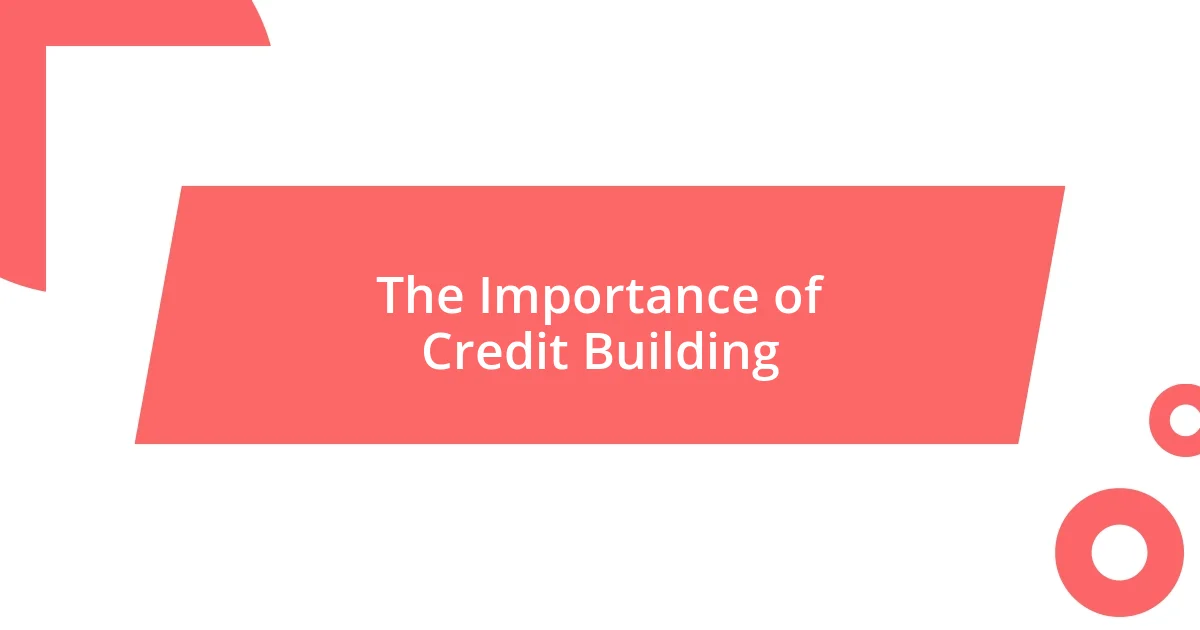
The Importance of Credit Building
Building credit is a pivotal step toward financial independence, and I can’t stress enough how much it can open doors for individuals and small business owners. I remember my own experience when I first secured a microloan; it felt like I had been given a key to a new world. Suddenly, opportunities I never thought possible were within reach. Establishing a solid credit history not only boosts your chances of securing larger loans in the future, but it also reflects your financial responsibility—a trait that’s increasingly valued by lenders.
Consider these key aspects of credit building:
- Access to Better Interest Rates: A strong credit score can lead to more favorable loan terms, saving you money in the long run.
- Increased Borrowing Power: With a good credit history, lenders are more inclined to extend larger amounts of credit, allowing for greater business expansion or personal investments.
- Employment Opportunities: Some employers check credit reports as a part of their hiring process, particularly in financial roles; a good score can enhance your job prospects.
- Confidence in Financial Decisions: Knowing you have a strong credit profile can empower you to make bolder financial moves, whether it’s starting a business or investing in real estate.
Reflecting on my journey, the initial struggles of building credit felt daunting, but with each responsible step, I noticed how it transformed not just my financial status but my mindset, too. It became a source of pride—proof that diligence pays off.
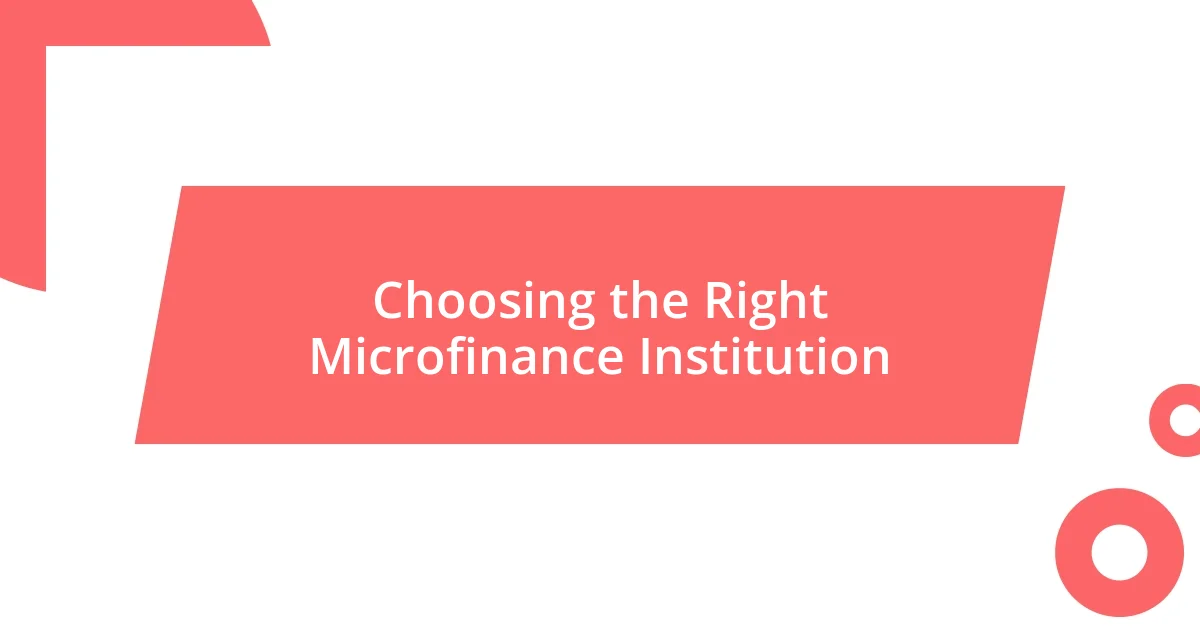
Choosing the Right Microfinance Institution
Choosing the right microfinance institution (MFI) is essential to your journey in building credit. From my experience, not all MFIs are created equal. I recall a time when I was overwhelmed by the options available. It became clear that I had to evaluate each institution carefully, focusing on their reputation, loan terms, and customer support. These factors made a significant difference in my journey towards achieving financial independence.
When I compared different MFIs, it struck me how crucial it was to find one that aligned with my needs and values. Some institutions offered flexible repayment plans, which eased my financial burden, while others charged high-interest rates that could have jeopardized my credit-building efforts. I remember choosing an MFI that not only provided favorable terms but also had a strong community focus. The feeling of being supported rather than just seen as a number was invaluable to my confidence as a borrower.
It’s important to ask yourself key questions during this selection process. Does the institution have a clear understanding of your unique circumstances? Are they transparent about their fees? I learned that a personal connection with my lender was essential. One lender even took the time to understand my goals and aspirations, which built trust and made my experience all the more fulfilling.
| Criteria | Institution A | Institution B |
|---|---|---|
| Reputation | Established with positive reviews | New with mixed feedback |
| Loan Terms | Flexible repayment, lower interest | High-interest rates |
| Customer Support | Responsive and helpful | Limited assistance |
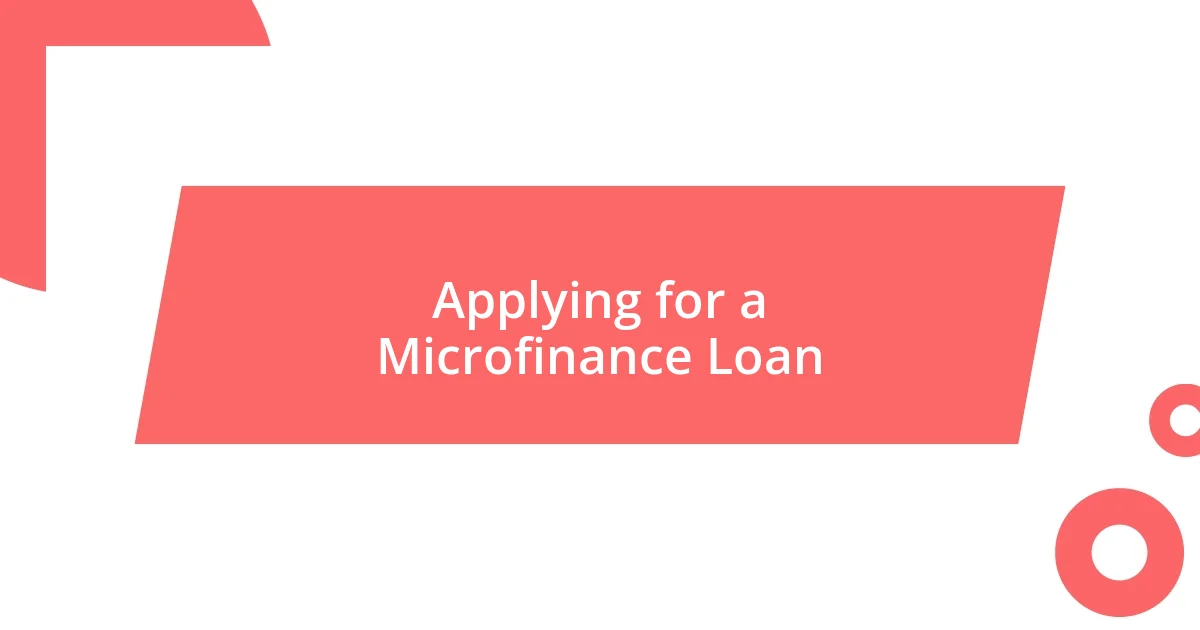
Applying for a Microfinance Loan
Applying for a microfinance loan felt like stepping into uncharted territory for me. I remember applying for my first loan and feeling a mix of excitement and anxiety. The process was more straightforward than I anticipated; paperwork involved verifying my income and outlining my business plan. It made me realize how critical it is to be well-prepared, as having everything in order not only boosts your chances of approval but also presents you as a responsible borrower.
As I navigated the application, I found that my confidence grew with each step. It struck me how crucial clarity was when articulating my reasons for seeking a loan. I chose to share my vision openly, discussing how the funds would help me reach my financial goals. This transparency fostered a connection with the loan officer, which made me feel more like a partner than just another applicant.
One lesson stood out from the experience: patience is key. There were moments of waiting and uncertainty that tested my resolve. But reflecting on that time, I learned that persistence pays off. Have you ever felt like giving up during a challenging process? I certainly did, but ultimately, it was that perseverance that led to a successful application, paving my way toward financial independence.

Managing Small Loans Effectively
Managing small loans effectively can be a delicate balancing act, but I found it incredibly rewarding once I got the hang of it. I remember the first time I made a loan repayment on time; the pride I felt was indescribable. It wasn’t just about meeting deadlines; it was about building my credibility as a borrower. Staying organized became my secret weapon—I set reminders and tracked my payments, ensuring I didn’t miss a single one.
Another crucial element I discovered was budgeting. At first, I was tempted to use all the loan funds at once, but my better judgment steered me towards a more thoughtful approach. Allocating specific amounts for various expenses helped me manage my finances effectively while also ensuring I could meet my repayment goals. Have you ever been in a position where you’ve felt the pinch after splurging too early? I definitely have, and it taught me the value of restraint and planning.
Communication with my microfinance institution ended up being a game changer, too. I learned that proactively reaching out about my situation—especially if I faced financial hurdles—was a wise move. For instance, when I had unexpected expenses pop up, I contacted my loan officer to discuss options. Their willingness to work with me made me realize that the relationship I built with them was just as important as the loan itself. What strategies have you used to navigate the complexities of small loans? I’d love to hear your thoughts!

Tracking Your Credit Progress
Tracking your credit progress is an essential part of building a solid financial reputation, especially after venturing into microfinance. I remember downloading my first credit report out of sheer curiosity. It was both eye-opening and nerve-wracking. Seeing my score fluctuate in real-time provided a sense of accountability I hadn’t anticipated. I began to understand that every action mattered, from timely repayments to managing my credit utilization ratio.
One of the best practices I adopted was setting regular check-ins on my credit status. Initially, it seemed daunting—after all, who wants to face the numbers if they aren’t as high as expected? But I realized that by acknowledging my progress (or setbacks), I could strategize better. For instance, I noticed that after paying off a small loan ahead of schedule, my score ticked up significantly. Reflecting on moments like these truly reinforced my commitment: What could be more motivating than seeing tangible results?
I also discovered the importance of understanding the components of my credit score. At first, I found it overwhelming, but it became clear that knowledge was power. As I tracked my progress, I began focusing on factors such as payment history and the length of credit usage—knowing what impacted my score made a huge difference. Have you ever felt caught in the dark, unsure of how your financial habits were affecting your credit? I know I did until I made it a priority to learn. Now, I view tracking my credit as a vital tool for growth—one that empowers me to make informed financial decisions moving forward.
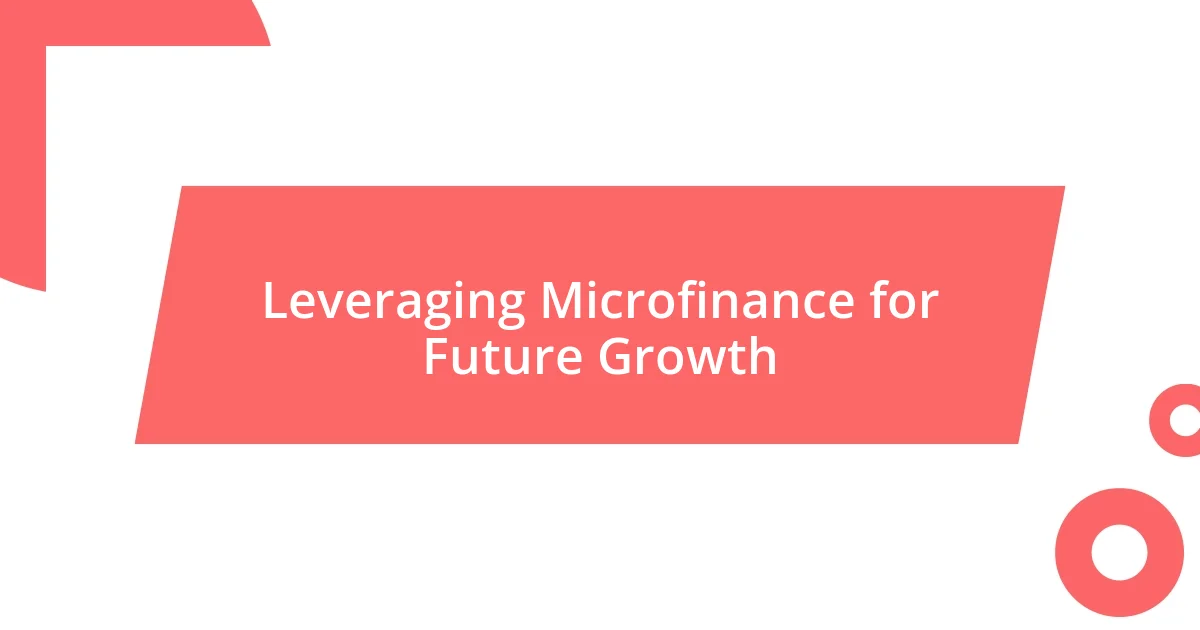
Leveraging Microfinance for Future Growth
When I think about leveraging microfinance for future growth, one of the pivotal moments was recognizing the potential to reinvest profits back into my business. After paying off my first loan, I took a leap of faith and used the extra funds generated to purchase new inventory. This decision wasn’t just about expanding— it marked the beginning of a cycle of growth I hadn’t realized was possible. Have you ever felt the thrill of taking a calculated risk that paid off? That moment changed my mindset entirely, from mere survival to unleashing the potential of my venture.
It’s fascinating how microfinance can serve as a springboard for broader financial opportunities. By building relationships with microfinance institutions and responsibly managing my loans, I opened doors to larger credit avenues. I remember sitting in a meeting with my loan officer, discussing future aspirations and how they could support my vision. Their belief in my potential was a boost I needed. Have you ever felt that weight lift when someone else sees your ambition? That conversation paved the way for me to secure additional funding down the line.
Moreover, I found that networking with other microfinance borrowers enriched my understanding of different approaches to growth. Sharing experiences with fellow entrepreneurs allowed me to brainstorm strategies I hadn’t considered before. One insightful discussion led me to diversify my offerings based on local demand, which ultimately increased my sales. Isn’t it amazing how collaboration can spark new ideas? This community aspect of microfinance not only bolstered my confidence but also solidified my vision for sustainable growth in the future.












